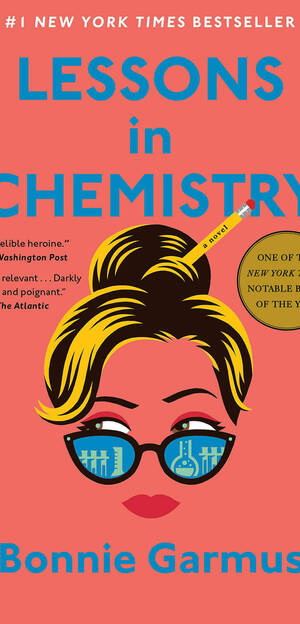I have a confession to make: I am a writer. I have a hard time reading a book just for the story. Often I’m peeking behind the curtain, sussing out the tools the writer uses to make that story — point of view, verb tense, the objective correlative — see what I mean?

Bonnie Garmus’ debut novel, Lessons in Chemistry, still on The New York Times’ bestseller list more than a year after publication, came into my life after a very long spell of my own not-writing, so I had the pleasure of reading the story for the story. I did not get hung up on tools or structure. And I had fun.
Garmus had me on page 1: It is 1961 and a mother is packing her daughter’s lunch, albeit in a laboratory and with the certainty that “her life was over.”
The premise is believable. What mother hasn’t had a bad day? And despite that, she’s the one packing the lunch, getting the day started. Just, what was that part about in a lab? I’ve packed lunches in some unusual places, but never in a lab. And it’s 1961. How many women were there in labs? And her life is over?
I wanted to know what would happen to Elizabeth Zott. Spoiler alert: I am giving away the ending.
Zott is the host of an afternoon cooking show, Dinner at Six, that is famously famous. Even the American president has seen and glowed about it.
But before she became a television host, Zott was a graduate student in chemistry at UCLA. More intrigue. Not a lot of women were studying chemistry at that level in the 1950s — but this is the University of California, the geographication of liberal for American readers.
However, in Zott’s case, no degree ever follows. She is 10 days shy of graduation when her faculty mentor finds her in the lab late at night checking test protocols, which is to say, putting in the extra effort she knows she must make to stay on his otherwise-all-male research team. Again, things are tracking.
When Zott tells her mentor of an error she believes she has found, he is irritated and determines to cover it up. He starts by putting his student back in her place, which means he tries to rape her. She escapes by stabbing him with a pencil. While he is rushed to the hospital, campus police pressure Elizabeth over and over . . . and over to make a statement of regret. She finally does: She regrets not having more pencils.
Clever, and all too real.
From there, Elizabeth finds a position in a lab. Male colleagues mistreat her. Only one does not.
The tragedy in Lessons in Chemistry never overpowers the story. Garmus is a genius at buoying inequality and trauma with humor, resilience and the stark reality of a character who has nowhere else to go but through. Even Zott’s dog is a full-fledged character with emotion, motivation and internal dialogue that is just, well, so very much dog. The writing is brilliant.
I eagerly bought into the fictional dream until the very end: Elizabeth is saved by a wealthy female benefactor.
Can women save women? You bet. Were there wealthy female benefactors in the early 1960s? Absolutely. Did I want Elizabeth to prevail in her field of choice due to her intelligence and ability? One hundred and ten percent.
Because women don’t actually need saving. Elizabeth is no damsel in distress. She is a woman emasculated — pun intended — by a system seeped in misogyny. When women outsmart the system . . . and change it? That’s the ending I want.
I do not want one opportunity to open up for one woman at one point in time. I want change. I want laws to change. I want men and women to change. I want society to change.
Perhaps, however, that revolution of change begins with one woman helping another woman. Perhaps it takes a deus ex machina kind of shift because that shift is so incongruent to society.
Today, women are succeeding in a far wider variety of careers than in the 1960s. We have come a long way. Yet, some obstacles to success are still stubbornly entrenched. There is no federally protected maternity leave, no expansive, affordable system of childcare, and women still do not make as much as men. We still have a way to go.
Lessons in Chemistry is well worth the read not only for the insight and inspiration but also for Garmus' sharp wit and excellent writing. It is a story that stays with the reader, encourages her to think. It encouraged me to look at what I can do, how I can support people on the margins in a meaningful way. As someone who works with low-income, first-generation students and students with disabilities, this goal suffuses my work. Garmus’ novel helps me rethink how I approach this support, how I approach meaningful change. The reader, writer and ally in me are grateful for that power in a story.
Stacy Nyikos is the director of Student Support Services at Cal Poly San Luis Obispo and the author of many award-winning books for children. Discover more of her work at stacyanyikos.com.